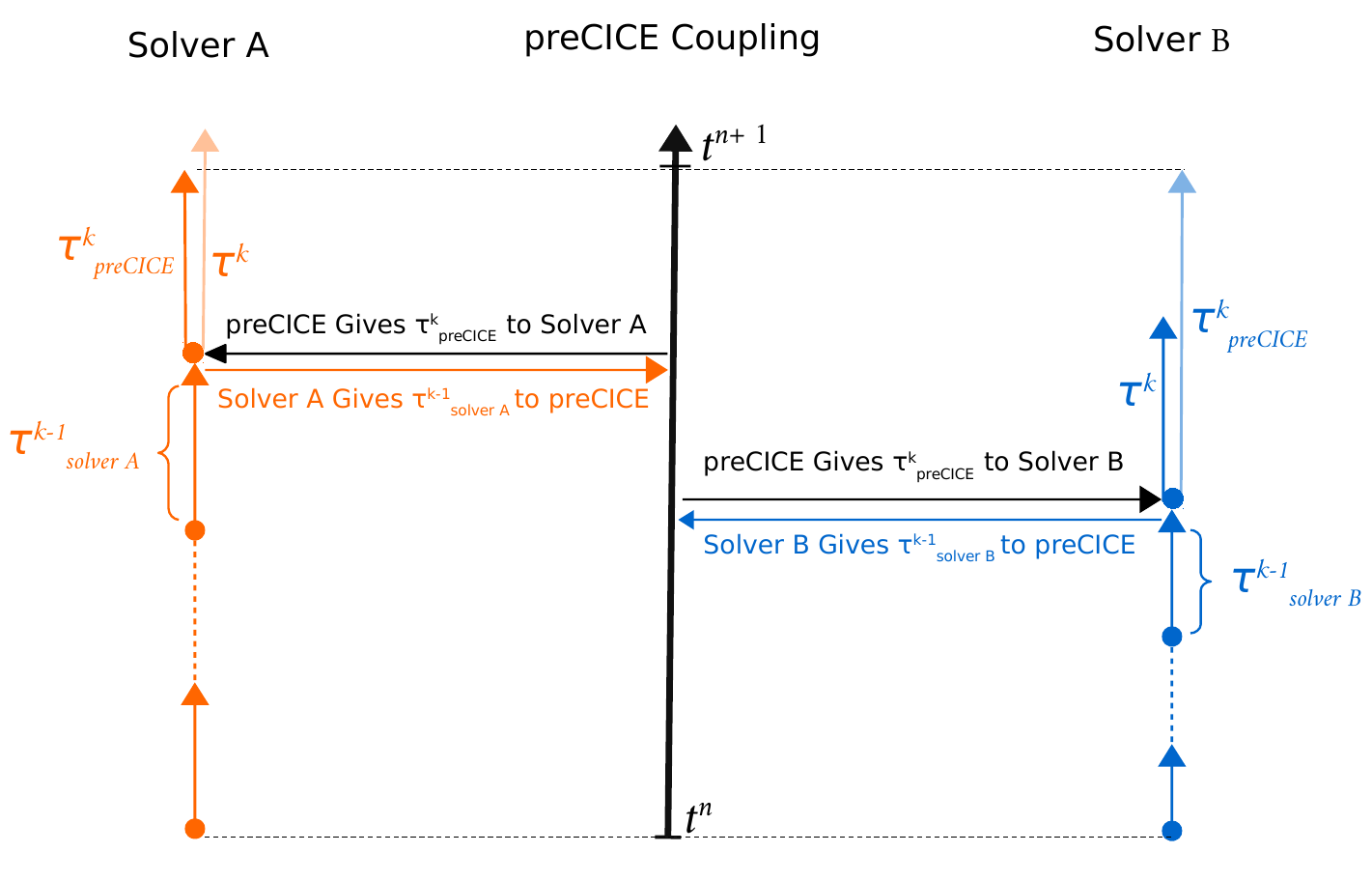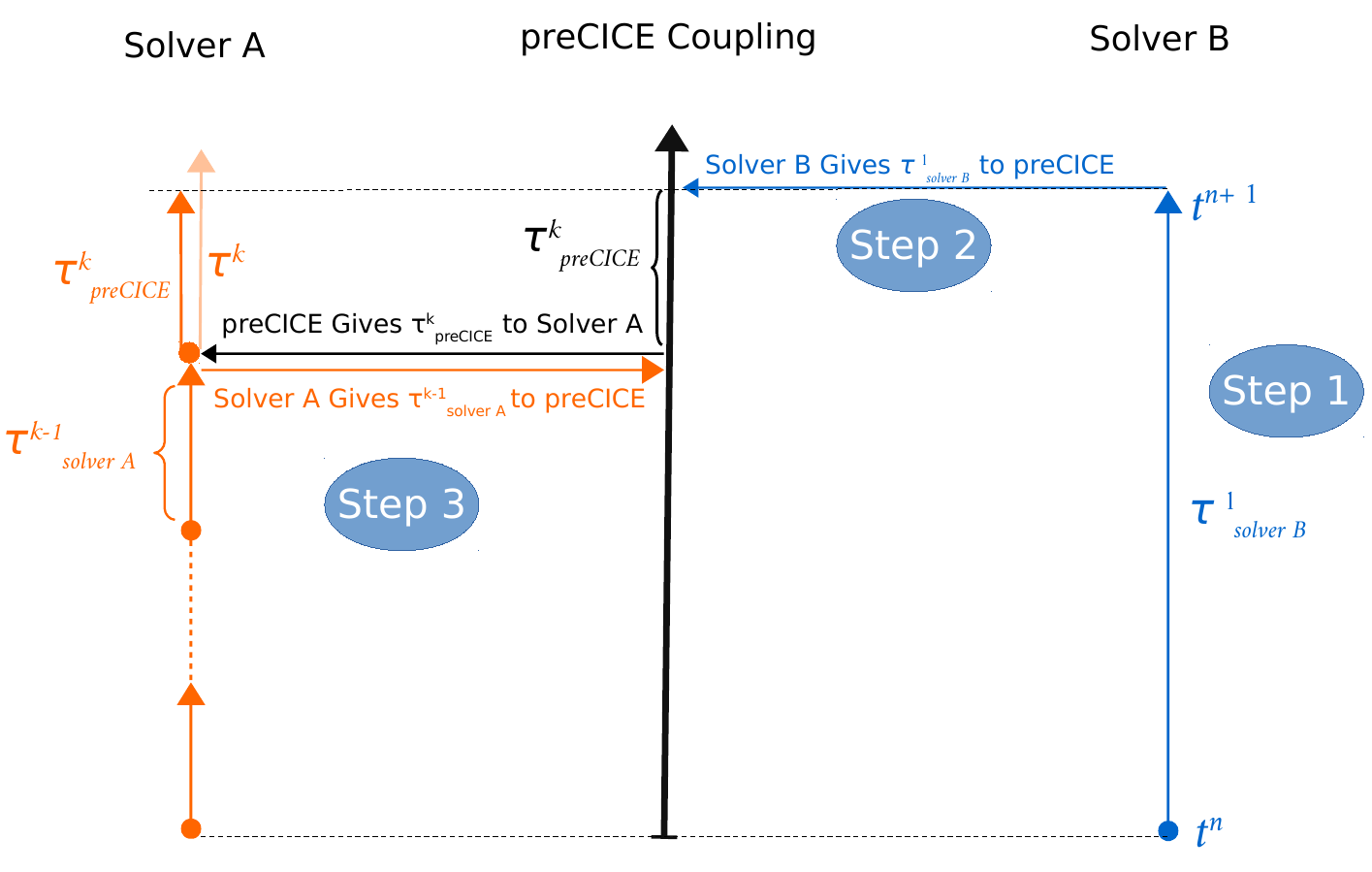In previous steps, you have already seen that there are quite some things going on with time step sizes. Let us now have a look at what is actually happening.
...
double solverDt; // solver time step size
double preciceDt; // maximum precice time step size
double dt; // actual time step size
precice.initialize();
while (not simulationDone()){ // time loop
preciceDt = precice.getMaxTimeStepSize();
solverDt = beginTimeStep(); // e.g. compute adaptive dt
dt = min(preciceDt, solverDt);
solveTimeStep(dt);
precice.advance(dt);
endTimeStep(); // e.g. update variables, increment time
}
...
solver_dt = 0 # solver time step size
precice_dt = 0 # maximum precice time step size
dt = 0 # actual time step size
precice.initialize()
while not simulation_done(): # time loop
precice_dt = precice.get_max_time_step_size()
solver_dt = begin_time_step() # e.g. compute adaptive dt
dt = min(precice_dt, solver_dt)
solve_time_step(dt)
precice.advance(dt)
end_time_step() # e.g. update variables, increment time
Good thing to know: in this step, you do really not have to alter your code. Everything needed is already there and can be configured. :relieved:
There are basically two options to choose from in the configuration.
<time-window-size value="..." method="..."/>
method can be:
fixed: A fixed time window with sizevalueis prescribed, during which both participants can use whatever time step sizes they want. Communication of coupling data happens only after each time window.first-participant: The first participant prescribes the time step size for the second one. Communication of coupling data happens after each time step. This option is only available for serial coupling schemes (more about configuration of coupling schemes). The attributevalueis not applicable.
Let us have a closer look at both options.
Fixed time window
The preCICE configuration defines a fixed time window. Both participants can use smaller time step sizes, but then they subcycle, i.e. coupling data is only communicated at the end of each time window. The figure below illustrates this procedure (k is the subcycling index, the dashed lines mark the time window):

- After each time step, both participants tell preCICE which time step size
dtthey just used by callingprecice.advance(dt). This way, preCICE can keep track of the total time.preciceDtis the remainder time to the next window:
preciceDt = precice.getMaxTimeStepSize();
precice_dt = precice.get_max_time_step_size()
- Both participants compute their next (adaptive) time step size. It can be larger or smaller than the remainder
preciceDt.
solverDt = beginTimeStep();
solver_dt = begin_time_step()
If it is larger, the remainder preciceDt is used instead (orange participant, dark orange is used).
If it is smaller, the participant’s time step size solverDt can be used (blue participant, dark blue is used).
These two cases are reflected in:
dt = min(preciceDt, solverDt)
dt = min(precice_dt, solver_dt)
- Once both participants reach the end of the time window, coupling data is exchanged.
Possible subcycling pitfall
If you are using very many small time steps in one window, you might see the following warning:
preCICE just returned a maximum time step size of <SOME DT>. Such a small value can happen if you use many sub steps per time window over multiple time windows due to added-up differences of machine precision.
The last time step ended up close to the end of the time-window without reaching it, leading to a very small final time step. Such small time steps can lead to problems in the solver.
One strategy to avoid this situation is to extend the last time step of a time window preventing problematic time step sizes.
The follow example extends the time step negotiation between the solver and preCICE to ensure the next time step size preciceDt - solverDt stays over some threshold minDt.
...
solverDt = beginTimeStep(); // e.g. compute adaptive dt
// Can lead to using a dt that only approximately reaches end of time window
// dt = min(preciceDt, solverDt);
// Specify a minimal time step size
double minDt = 10e-14;
if (preciceDt - solverDt < minDt) {
// The next time step would be too small or surpass the end
dt = preciceDt;
} else {
dt = solverDt;
}
precice.readData("FluidMesh", "Displacements", vertexIDs, dt, displacements);
setDisplacements(displacements);
solveTimeStep(dt);
computeForces(forces);
precice.writeData("FluidMesh", "Forces", vertexIDs, forces);
// if dt = preciceDt, we will exactly reach the end of the window when calling advance
precice.advance(dt);
...
...
solver_dt = begin_time_step() # e.g. compute adaptive dt
# Can lead to using a dt that only approximately reaches end of time window
# dt = min(precice_dt, solver_dt);
# Specify a minimal time step size
min_dt = 10e-14
if precice_dt - solver_dt < min_dt:
dt = precice_dt
else:
dt = solver_dt
displacements = precice.read_data("FluidMesh", "Displacements", vertex_ids, dt)
set_displacements(displacements)
solve_time_step(dt)
forces = compute_forces()
precice.write_data("FluidMesh", "Displacements", vertex_ids, forces)
# if dt = preciceDt, we will exactly reach the end of the window when calling advance
precice.advance(dt)
...
First participant prescribes time step size
The first participant sets the time step size. This requires that the second participant runs after the first one. Thus, as stated above, this option is only applicable for serial coupling.

- The blue participant B is
firstand computes a step with its time step size (Step 1). - In
advance, this time step size is given to preCICE (Step 2).
precice.advance(dt);
precice.advance(dt)
- preCICE has tracked the time level of the orange participant A and returns the remainder to reach B’s time step size.
preciceDt = precice.getMaxTimeStepSize();
precice_dt = precice.get_max_time_step_size()
- A computes its next (adaptive) time step size. It can now be larger or smaller than the remainder.
solverDt = beginTimeStep();
solver_dt = begin_time_step()
If it is larger, the remainder preciceDt is used instead (the case below in Step 3, dark orange is used).
If it is smaller, the participant’s time step size solverDt can be used (not visualized).
These two cases are again reflected in the formula:
dt = min(preciceDt, solverDt);
dt = min(precice_dt, solver_dt)
- The procedure starts over with the blue participant B.
preciceDt on the blue side is always infinity such that min(solverDt,preciceDt)==solverDt.
fixed and first-participant timestepping. Everything can be configured. Even if implicit coupling is used.
Steering the end of the simulation
One last thing about time. There is also a helper function in preCICE that allows you to steer the end of a coupled simulation:
bool isCouplingOngoing();
is_ongoing = is_coupling_ongoing()
This functions looks at max-time-windows and max-time as defined in the preCICE configuration and knows when it is time to go. Then, you should call finalize. It replaces your simulationDone().
while (precice.isCouplingOngoing()){ // time loop
...
}
precice.finalize();
while precice.is_coupling_ongoing(): # time loop
...
precice.finalize()